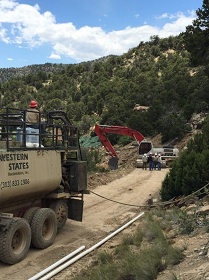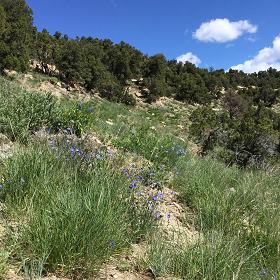Reclamation Efforts in Colorado
Oil and gas operators on BLM public lands in Colorado not only have to meet strict reclamation standards from the BLM. They must also meet some of the most stringent state reclamation standards in the country.
In the summer of 2015, Encana’s reclamation staff, which later continued working with Utah Gas Corp when the lease changed hands, reclaimed a road well over 40 years old on BLM land in western Colorado’s Piceance Basin. The access road served a single-well pad and was over half a mile in length. Back then, road design standards and construction best management practices were much different than they are today, which created numerous challenges and site constraints. Much of the original topsoil had eroded over the years, leaving only subsoil and rock. Soil tests revealed a slightly alkaline pH, very low organic matter and very little evidence of microbial activity. In addition, the road traversed a steep, south-facing slope with frequent rock fall that impeded vehicular travel.
Despite these challenges, the reclamation team used a variety of innovative techniques to achieve successful reclamation. After working with the BLM Colorado River Valley Field Office to evaluate the site constraints and develop a comprehensive reclamation plan, the company used heavy equipment to meticulously sculpt the access road back to its original contour. Excavators ripped the compacted road surface, loosened the soil for seed bed preparation, removed old culverts and restored the original drainages. Surface roughening techniques were employed to control erosion, create micro-sites that promote seed germination, as well as improve the visual aspect and texture of the reclaim. Boulders were strategically placed to mimic natural outcrops and drainages, and help blend the roadway into the surrounding landscape. During the re-contouring stage, the team also transplanted native shrubs, forbs and trees, such as sagebrush, blue flax and juniper trees. Holes were excavated for the transplants, then the shrubs, forbs, and small trees adjacent to the work area were carefully scooped with an excavator bucket and placed into the holes. This “grab” transplanting technique vastly improves the visual and ecological aspects of the job while providing mature plants that “jump-start” the site reclamation.

Immediately following re-contouring and seed bed preparation, the road was broadcast seeded with a BLM-approved weed-free native seed mix, designed for the surrounding pinion/juniper woodland vegetation community. To improve soil fertility, commercially available reclamation products were applied that added organic matter and naturally-occurring microorganisms to the reclaimed surface. These products improve soil structure, nutrient cycling and water retention, as well as enhance the germination, establishment and growth of the seeded plants. In addition, an organic poultry and fish-based amendment was applied to enhance soil microbial activity.
The equipment operators and a hydro-mulch crew worked concurrently. Immediately upon the road recontouring and seedbed preparation, the seeding/mulching crew followed, maneuvering hundreds of feet of hose around the heavy equipment. They mixed the organic amendment with seed and other amendments, and then applied a second application of hydro-mulch over the top. This practice, commonly known as hydro-mulching, has numerous benefits, such as holding soil in place and protecting it from wind and water erosion, keeping seeds moist during germination, protecting new plants, and preventing seedlings from drying out.

(dark green material shown). Photo taken June 2015.

was still present. Photo taken April 2016.
Less than three full growing seasons later, the road reclamation now exhibits a self-sustaining, diverse mix of native grasses, shrubs, and forbs. In future years, the reclaimed road will become less noticeable as the “grab” transplanted vegetation matures and flourishes, and while shrubs and juniper trees recolonize the site from the edges. Regardless of challenging site constraints such as decades-old disturbance, southern aspects, steep topography, and soils with virtually no organic matter, successful and timely reclamation can still be achieved.

communities. Photo taken May 2017.
A special thanks to Steve Hale of Utah Gas Corp for planning this state-of-the-art reclamation and for contributing some of the photos for this story.
